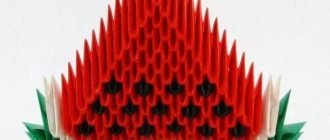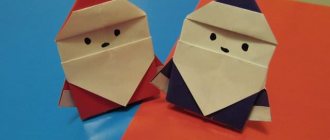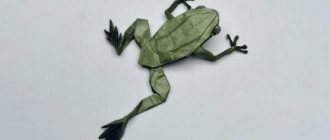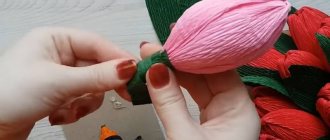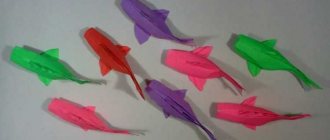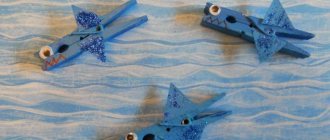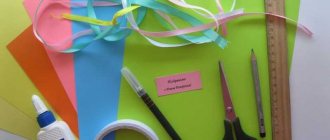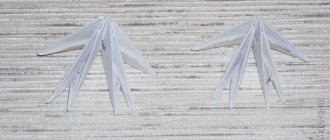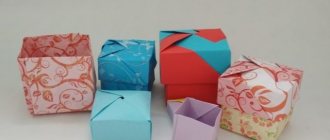2018-01-16 23:53:11 0 6401
The art of origami is an ancient art that originated in China and eventually spread to Japan. Translated, this beautiful word means “folding paper.” In the past, only wealthy Japanese could practice origami, but today this exciting and useful activity is available to everyone. Friedrich Froebel brought the secrets of the art of folding paper figures to Europe. Paper origami classes are available to all children, even the smallest, you just need to select tasks according to the child’s level of preparation .
Circuit examples
We offer many different schemes. But, of course, kids cannot complete crafts the first time. It takes skill. It's like puzzles - it requires perseverance and careful handling of the material used. You can fold a lot of different origami from plain paper for children 3-4 years old, useful little things, valentines, hares, animals, birds, thereby creating comfort in the house. The admiring glances of the guests will definitely appreciate such painstaking work.
Valentine cards are also a kind of individual crafts. These are not simple paper hearts, but rather complex models neatly folded into modules.
All the best origami patterns can be viewed at the links below for children 5-6 years old. Children can make a seal, a fox, a camel, a hare, a bird, autumn leaves, a cat, a flower.
Origami is a real art and all you need is colored paper and scissors. You should definitely study the diagrams first in order to put the model elements in the right order. It relaxes well, concentrates attention, and develops finger motor skills.
Modular technology is a new phenomenon for children today. You can create truly mesmerizing crafts that amaze with their beauty and variety. See photos and videos for examples of completed works for children aged 7-8 years.
How to make origami crafts with children
The child will not be able to start practicing paper origami on his own; here he needs help and clear guidance from an adult (parent or teacher). Children love to study with adults; this helps them bond. You should start with the simplest figures that can be completed in one approach.
It will be interesting to combine origami classes with other forms of art. For example, a child will paint a finished figurine with great interest. It is interesting to decorate the figurine with applique, glue beady eyes or a fluffy tail to the animal. You can even create a three-dimensional applique by gluing beautiful flowers onto whatman paper.
At the initial stages, you can interest the young researcher by telling a fairy tale during the lesson. Any adult can easily come up with a story, for example, “The Tale of a Piece of Paper,” “The Tale of a Frog” (bear, bunny, bird), etc. You should start from the topic of the lesson.
Older children can diversify their activities with paper with stories about its origin, ancient China and Japan, and modern paper production technology.
When putting together animal figures, you should at the same time talk about their habitat, nutrition, and appearance, expanding the child’s erudition. When enough paper figures have accumulated, you can organize a theatrical performance. For the baby, this will be a real adventure with a storm of positive emotions.
During paper origami classes, an adult should behave patiently and try to interest the child. If something doesn’t work out for the child the first time, if the folds are not straight and the figures are crooked, the adult is still obliged to praise the craft and the creator, making him want to continue doing it.
The duration of the lesson should not exceed half an hour; if the child is tired, you can entertain him with finger exercises.
Below are the simplest origami for children. This is where you can begin to immerse your child in the fascinating world of origami.
Easy paper origami - “Dog”
Scheme
Video
Others similar in manufacture
Puppy
Chanterelle
Koala
Kitty
Baby elephant
Origami for children “Frog - Jump”
Scheme
Video
Two more versions of origami step by step “Mouse”
Scheme
Video
Origami from colored paper “Little Penguin” and “Emperor Penguin”
Scheme
Video
What is the difference?
What is the difference between modular origami and classic? And since you will need at least 6 identical modules in each row, there are also quite a lot of sheets of colored paper. But the result is worth it. A little perseverance and patience and you can make real masterpieces that will be the envy of others.
The origami method consists of connecting all the modules to each other, connecting the structure, giving it various shapes.
In your work, you can use PVC glue and thereby create any figures of different colors and sizes. The more sheets of paper are used in the work, the more difficult it is to come up with a design structure from triangular elements, which is suitable for older children: 11-12 years old and 13-14 years old.
Origami schemes:
Let's start working
- In Russian folklore, the birch tree is compared to a slender and beautiful girl. But indeed, there is something equally naive, pure, attractive in the birch tree;
- Swan made of modules. Assembling the figure is not difficult, the only thing is that it takes a lot of time. This swan is suitable as a gift for a birthday, a wedding celebration, or a wedding anniversary;
- Vase with rose. For this work, a diagram of a modular painting was taken, only made in a circle. They put a glass inside - you can already put flowers;
- Cat made of paper modules. This cat looks beautiful in any home! Everyone likes her. This craft required more than a thousand triangular modules;
- "Russian beauty". In this master class we invite you to assemble the figure of a girl in Russian folk costume: sundress, shirt, headband. In a similar way, you can collect figures in other national traditions;
- Transformer. An interesting type of crafts made from modular origami are transformers. They can be assembled in different ways and get different shapes. Try creating a transforming craft.
Today on the Internet you can find various origami schemes from modules in Russian for children 9-10 years old. Many of them contain video tutorials. The level of proficiency in this art can be improved through ordinary practice. Perhaps in the future you will be able to create your own designs for your own figurines of animals or flowers, or maybe something more complex.
Simple origami for children: diagrams
Origami “Bunny” for children 1) Take a square sheet of thick paper2) Fold its two sides diagonally so that you get a shape similar to a diamond, but one side should be slightly shorter than the other3) Make a small cut in the center of the sheet, starting on the longer side of the diamond4) Fold the sheet in half so that the cut is on top5) Bend one of the triangles formed from the cut upward (this will be the eye)6) Fold it in half so that the eye becomes half the size, and the remaining part becomes into the bunny's face, on which you can now draw an eye7) Do the same with the second side8) Now your bunny's body looks like a triangle. Mentally (or with a pencil) draw a line from its top (located at the bottom) to the center of the base (located at the top) 9) Fold the far part of the triangle (the one that is further from the muzzle) inward. Done! If desired, the bunny can be painted in any colors.
Origami for children “Fish“ 1) Fold a square sheet of paper in half to make a triangle2) Fold its edges towards the center so that you again have a square (but keep it in the future in the shape of a diamond, that is, with the angle down)3) Fold the triangles , of which the surface of your square now consists, in half4) Now fold each of the triangles on top twice more, bending down only the top layer of paper5) Fold the smallest triangles in half again, mentally drawing a line from their vertices located in center of the square, to the bases located on its sides 6) Now let’s take care of the bottom of the rhombus: fold the top layer of paper “valley” (that is, towards you) 7) Turn the resulting one over (that is, away from you) 8) Fold the uppermost triangle again “valley” “9) Bend its upper part into a “mountain”10) On both sides, cut one layer of diamond paper along the line that is the base of the largest triangle11) Turn the bottom of the triangles “mountainwise”12) Turn the result inside out.
The fish is ready! All that remains is to draw the eyes and decorate it! Both proposed patterns are origami for children 9 years old and older. In any case, at the first stage of a child’s acquaintance with a new hobby, parents are recommended to be present nearby and even actively participate in the process. Most likely, origami will captivate not only the child, but also the parents who started it all. So origami has every chance of becoming a real family hobby!
An origami flower stem is a necessary addition for a huge number of models. After all, any project can only be considered completed when it receives a completed design. And stems are the easiest and most reliable way to assemble origami paper flowers into a spectacular composition. We offer four patterns for stems using the origami technique. The models are arranged in order of increasing complexity of their manufacture. In addition, the first two patterns are flat, suitable for creating panels and postcards. And the flowers on these stems should be such that they can be glued to the surface of the base. By the way, flowers may not necessarily be made using origami technique. Such stems are also suitable for applique flowers. The last two stem patterns for origami flowers are three-dimensional. They do not require additional decoration and can stand on their own. Such origami stems are universal, suitable for any flowers - both flat and three-dimensional. Continue reading →
Origami in kindergarten
As already mentioned, origami is the art of creating various figures from paper. Thanks to the many different images conveyed using an ordinary sheet of paper, this direction of creativity is known throughout the world. In addition to the fact that this type of crafts has become a kind of hobby for many people, it is also included in the additional education program in preschool educational institutions. Studying the art of origami in a preschool educational institution is a wonderful method for developing intellectual and creative abilities in children.
Origami is not only a way to have an interesting pastime. Regular practice of this unusual type of creativity develops a lot of useful qualities and has a beneficial effect on thinking and intellectual development.
Video selection of simple origami for children
Goals and objectives of origami classes for preschoolers:
- Creative skills. Origami combines two types of brain activity: imagination and logic. This unique mind game harmonizes the hemispheres of the brain and activates the ability to find fresh ideas and create something new.
- Attentiveness. When creating any piece of paper, even a simple one, a strict sequence of actions is required. Therefore, origami in kindergarten is one of the most useful methods for developing attention in children.
- Concentration and perseverance. Before the age of 6, many children find it quite difficult to maintain attention on one object for a long time. The only way to develop perseverance and concentration is to find an interesting activity for the child that can completely absorb his attention.
- Beneficial effects on mental health. Doing these types of arts or crafts reduces anxiety levels. In addition to origami, there are a number of similar activities: plasticine modeling, bead weaving or embroidery. However, unlike paper crafts, working with a needle or small beads can be dangerous for a small child. Therefore, origami for preschoolers is an ideal option.
- Memory. Folding paper figures usually takes place in several stages. Due to the fact that children have to remember and reproduce the entire sequence of actions, memory develops.
- Development of aesthetic taste. The foundations of the concept of beauty and the sense of beauty are laid at an early age. It is very important at this stage of development not to miss the moment and to instill in children an aesthetic taste.
- Spatial thinking. Starting to master spatial geometry will help develop your imagination. In addition, some teachers believe that origami for preschoolers is a good help for further study of mathematical disciplines.
- Fine hand motor skills. The skill of folding paper requires precise and careful hand movements, since the correct folds determine how smooth and high-quality the paper work will be. In the future, this skill will help you more easily master various areas that also require finger dexterity. For example, playing musical instruments, drawing, various types of needlework, such as knitting, embroidery, beading. In addition, psychological research has revealed a direct connection between the development of fine motor skills of the hands and speech. Regular practice, which requires a subtle approach and precise, gentle finger movements, helps develop diction and articulation. Therefore, circle work in a preschool educational institution on origami will be very useful. Especially in speech therapy kindergartens.
